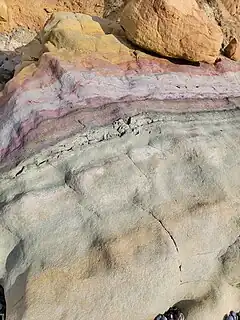| Delmar Formation | |
|---|---|
| Stratigraphic range: Lutetian | |
 A broken-off piece of a cliff on the Torrey Pines beach. Delmar Formation (green, bottom) transitioning to Torrey Sandstone (yellow, top). | |
| Type | Formation |
| Location | |
| Region | California |
| Country | United States |
The Delmar Formation is a geologic formation best exposed in seashore cliffs at Del Mar and Solana Beach in California, overlayed by Torrey Sandstone.[1] The formation rocks comprise the barrier bar[1] for Los Peñasquitos Lagoon[2] and have three sub-facies that can be classified as ancient oyster reefs (Ostrea idrianensis), tidal flats and sublittoral channels and ponds[1] The formation is a result of sedimentary infilling of a large Eocene Delmar lagoon[3] and contains fossils from that period. First identified as "Delmar Sand" by Hanna in 1926.[4] Frederiksen dates the formation as early Lutetian.[5]
Appearance
Delmar Formation consists of dark green claystone and mudstone, greenish-gray muddy sandstone, interbeds formed by biostromes of shells of molluscs.[6]
Setting
Frederiksen places the Delmar Formation and overlaying Torrey Sandstone above the Mount Soledad Formation and below Ardath Shale within the early Lutetian in calcareous nannofossils zone CP12.[7]
The boundary between Delmar Formation and Torrey Sandstone is not clear-cut, the two facies intermix extensively, it is not unusual to find Delmar strata in between Torrey rocks.[6]
The Delmar formation can be observed, together with Torrey Sandstone, for 20 kilometers along the seashore, from Encinitas to the Torrey Pines State Park, both extend up to 13 kilometers inland, and are expected to go to farther in the subsurface in the southwestern direction.[6]
Fossils
The formation contains microfossils (pollen, spores, etc.)[8] and macrofossils (mollusc shells),[9] with the latter indicating the brackish water conditions.[10] Plant material can be also found in the form of remains of grass blades and wood fragments.[11]
See also
References
- 1 2 3 Boyer 1974, Abstract.
- ↑ Boyer 1974, p. 13.
- ↑ Thomson & Abbott 1991, p. 82.
- ↑ Hanna 1926, as cited by Wosika 1975, p. 9.
- ↑ Frederiksen 1991a, p. 195.
- 1 2 3 Boyer 1974, p. 14.
- ↑ Frederiksen 1991b, p. 565.
- ↑ Boyer 1974, p. 19.
- ↑ Boyer 1974, p. 23.
- ↑ Boyer 1974, pp. 24–25.
- ↑ Boyer 1974, p. 28.
Sources
- Various Contributors to the Paleobiology Database. "Fossilworks: Gateway to the Paleobiology Database". Retrieved 17 December 2021.
- Boyer, Jannette Elaine (1974). Sedimentary facies and trace fossils in the Eocene Delmar Formation and Torrey Sandstone, California (PDF) (MA). Rice University.
- Thomson, Celeste; Abbott, Patrick L. (1991). "Petrography of Sandstones Associated with the Eocene Delmar Formation Lagoon". In Abbott, P. L.; May, J. A (eds.). Eocene Geologic History San Diego Region. Pacific Section SEPM. pp. 89–92.
- Frederiksen, Norman O. (1991a). "Petrography of Sandstones Associated with the Eocene Delmar Formation Lagoon". In Abbott, P. L.; May, J. A (eds.). Eocene Geologic History San Diego Region. Pacific Section SEPM. pp. 195–200.
- Frederiksen, Norman O. (December 1991b). "Pulses of Middle Eocene to Earliest Oligocene Climatic Deterioration in Southern California and the Gulf Coast". PALAIOS. 6 (6): 564. doi:10.2307/3514919. ISSN 0883-1351.
- Hanna, Marcus Albert (1926). "Geology of La Jolla Quadrangle". California: California University Publications in Geological Sciences Bulletin. 16 (7): 187–246.
- Wosika, Edward P. (May 23, 1975). Paleoenvironmental and paleogeomorphological implications of the combined Delmar-Ardath Middle Eocene pollen and spore flora (Delmar formation and Ardath Shale of the La Jolla Group), San Diego, California (Senior). SDSU.